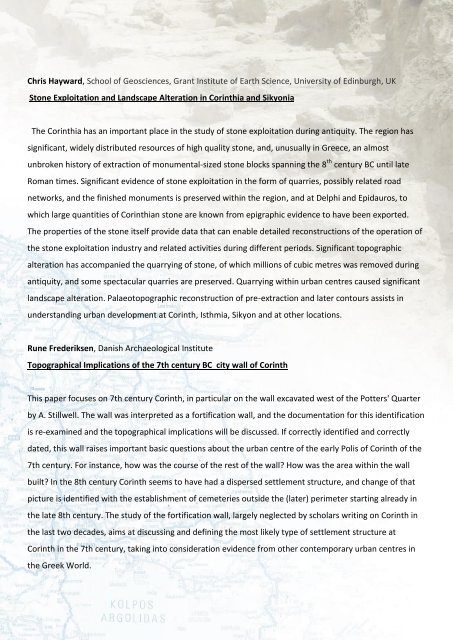ABSTRACTS - The American School of Classical Studies at Athens
ABSTRACTS - The American School of Classical Studies at Athens
ABSTRACTS - The American School of Classical Studies at Athens
Create successful ePaper yourself
Turn your PDF publications into a flip-book with our unique Google optimized e-Paper software.
Chris Hayward, <strong>School</strong> <strong>of</strong> Geosciences, Grant Institute <strong>of</strong> Earth Science, University <strong>of</strong> Edinburgh, UK<br />
Stone Exploit<strong>at</strong>ion and Landscape Alter<strong>at</strong>ion in Corinthia and Sikyonia<br />
<strong>The</strong> Corinthia has an important place in the study <strong>of</strong> stone exploit<strong>at</strong>ion during antiquity. <strong>The</strong> region has<br />
significant, widely distributed resources <strong>of</strong> high quality stone, and, unusually in Greece, an almost<br />
unbroken history <strong>of</strong> extraction <strong>of</strong> monumental-sized stone blocks spanning the 8 th century BC until l<strong>at</strong>e<br />
Roman times. Significant evidence <strong>of</strong> stone exploit<strong>at</strong>ion in the form <strong>of</strong> quarries, possibly rel<strong>at</strong>ed road<br />
networks, and the finished monuments is preserved within the region, and <strong>at</strong> Delphi and Epidauros, to<br />
which large quantities <strong>of</strong> Corinthian stone are known from epigraphic evidence to have been exported.<br />
<strong>The</strong> properties <strong>of</strong> the stone itself provide d<strong>at</strong>a th<strong>at</strong> can enable detailed reconstructions <strong>of</strong> the oper<strong>at</strong>ion <strong>of</strong><br />
the stone exploit<strong>at</strong>ion industry and rel<strong>at</strong>ed activities during different periods. Significant topographic<br />
alter<strong>at</strong>ion has accompanied the quarrying <strong>of</strong> stone, <strong>of</strong> which millions <strong>of</strong> cubic metres was removed during<br />
antiquity, and some spectacular quarries are preserved. Quarrying within urban centres caused significant<br />
landscape alter<strong>at</strong>ion. Palaeotopographic reconstruction <strong>of</strong> pre-extraction and l<strong>at</strong>er contours assists in<br />
understanding urban development <strong>at</strong> Corinth, Isthmia, Sikyon and <strong>at</strong> other loc<strong>at</strong>ions.<br />
Rune Frederiksen, Danish Archaeological Institute<br />
Topographical Implic<strong>at</strong>ions <strong>of</strong> the 7th century BC city wall <strong>of</strong> Corinth<br />
This paper focuses on 7th century Corinth, in particular on the wall excav<strong>at</strong>ed west <strong>of</strong> the Potters' Quarter<br />
by A. Stillwell. <strong>The</strong> wall was interpreted as a fortific<strong>at</strong>ion wall, and the document<strong>at</strong>ion for this identific<strong>at</strong>ion<br />
is re-examined and the topographical implic<strong>at</strong>ions will be discussed. If correctly identified and correctly<br />
d<strong>at</strong>ed, this wall raises important basic questions about the urban centre <strong>of</strong> the early Polis <strong>of</strong> Corinth <strong>of</strong> the<br />
7th century. For instance, how was the course <strong>of</strong> the rest <strong>of</strong> the wall? How was the area within the wall<br />
built? In the 8th century Corinth seems to have had a dispersed settlement structure, and change <strong>of</strong> th<strong>at</strong><br />
picture is identified with the establishment <strong>of</strong> cemeteries outside the (l<strong>at</strong>er) perimeter starting already in<br />
the l<strong>at</strong>e 8th century. <strong>The</strong> study <strong>of</strong> the fortific<strong>at</strong>ion wall, largely neglected by scholars writing on Corinth in<br />
the last two decades, aims <strong>at</strong> discussing and defining the most likely type <strong>of</strong> settlement structure <strong>at</strong><br />
Corinth in the 7th century, taking into consider<strong>at</strong>ion evidence from other contemporary urban centres in<br />
the Greek World.

















